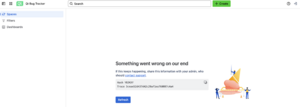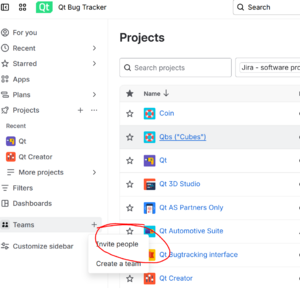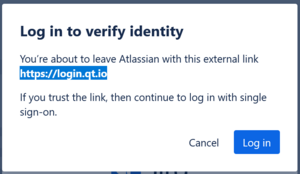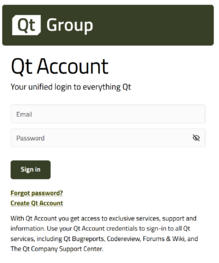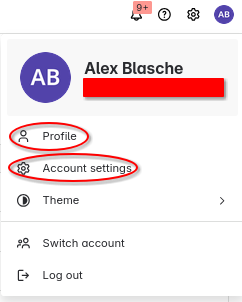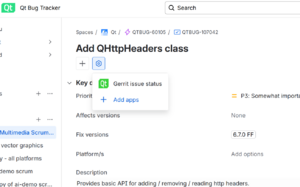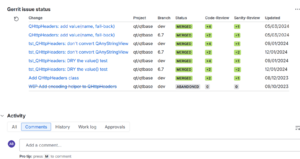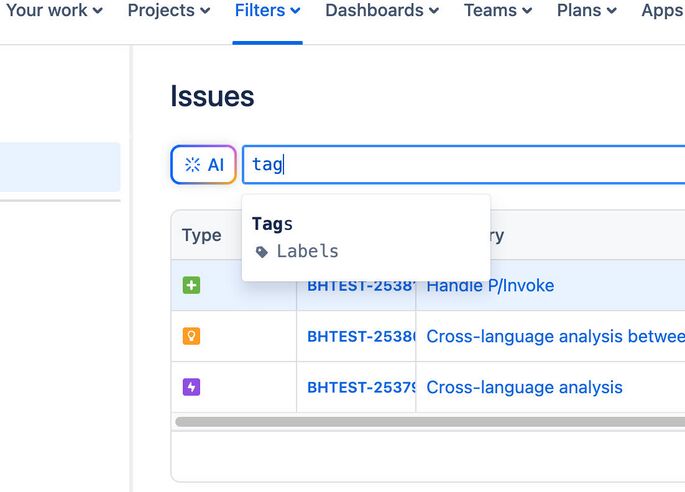Jira Cloud migration
This page is an FAQ for upcoming migration of Qt's bug tracking system (https://bugreports.qt.io/) to the Atlassian cloud (https://qt-project.atlassian.net/).
The migration happened from 21. November 2025 (16:00 CET) until 23. November 2025.
Rationale
In 2024 Atlassian discontinued the support for the Jira Server version. The only alternative option for Open Source usage is a Jira Cloud license. This means the current content from https://bugreports.qt.io must be migrated to https://qt-project.atlassian.net. After this migration, the original Qt BugReports will stay around as read-only reference for some time to come.
Migrated projects
The following projects will be/were migrated to https://qt-project.atlassian.net.
| Coin (COIN) | Qt Design Studio (QDS) | Qt Tools for Android (QTTA) | Qt AS Partners Only (QTAUTO) |
| Qbs ("Cubes") (QBS) | Qt Extensions (QTEXT) | Qt Visual Studio Tools (QTVSADDINBUG) | Qt Product Management Organization (QTPMO) |
| Qt (QTBUG) | Qt Installer Framework (QTIFW) | Qt WebBrowser (QTWB) | Qt Requirements Management (QTPM) |
| Qt 3D Studio (QT3DS) | Qt Playground Projects (QTPLAYGROUND) | Qt for Python (PYSIDE) | Qt Product Installation Framework (QTPIF) |
| Qt Bugtracking interface (QTJIRA) | Qt Project Website (QTWEBSITE) | VS Code Extension (VSCODEEXT) | |
| Qt Creator (QTCREATORBUG) | Qt Quality Assurance Infrastructure (QTQAINFRA) | Qt Automotive Suite (AUTOSUITE) |
This is not the complete list of all projects on bugreports. In particular old projects or QtC internal projects were left behind. Other cases involve The Qt Company specific projects which were migrated to a different Jira Cloud instance.
Timeline & Target
The target server is https://qt-project.atlassian.net.
| State | Status | Time Line | Description |
|---|---|---|---|
| Test migrations | Done | Started on 16. June 2025 | Admin working on playbook for migration. Users cannot log into the instance yet but the Jira cloud instance is publicly visible. |
| User acceptance tests | Done | November 2025 | Voluntary testers collect first impressions, log in and can interact with a copy of the data. |
| Final migration | Done | 21. - 23.11.2025 | The day when the data is moved for good and bugreports becomes read-only. |
Link redirection & History preservation
After the migration completed, https://bugreports.qt.io were moved to a new URL: https://bugreports-test.qt.io. A URL redirect was added:
- https://bugreports.qt.io -> https://qt-project.atlassian.net
- https://bugreports.qt.io/browse/QTBUG -> https://qt-project.atlassian.net/browse/QTBUG
- https://bugreports.qt.io/browse/QTBUG-45444 -> https://qt-project.atlassian.net/browse/QTBUG-45444
After this redirection becomes active, the "bugreports-test" will serve for historical reference only. It will continue to exist for the time being but might eventually be removed. All projects on "bugreports-test" have been changed to read-only permission schemes.
For links from this wiki to bug reports, this wiki has templates {{Issue|...}} for tickets on the active server and {{OldJira|...}} for those on the legacy mirror, in case anyone needs to reference tickets on non-migrated projects. For example, {{Issue|QTBUG-128191}} displays as QTBUG-128191 and links to the new server. You can optionally supply a second argument as the link text: thus {{Issue|QTBUG-128191|QtCore: unit test failures when feature flags are disabled}} displays as QtCore: unit test failures when feature flags are disabled. Although the redirects above will keep old direct links working, using these templates is both terser to type and easier to redirect if we ever move the servers again – editing the URL in one template fixes all uses of it.
First login
The Jira instance is configured such that a login is not required to browse the content of the server. If you want to create bugs, comment or simply track activity on an issue you need to log into Jira. Please verify whether you are logged in by checking the top right corner of your screen:
Since we are using the Atlassian cloud infrastructure, there is an additional Atlassian account login required. That's the first level of required authentication. In addition, the cloud server uses the Qt Account system for authentication purposes (same as bugreports.qt.io). The next sections provide details how an Atlassian account can be accessed in case of migrated users or how first time users can access the Jira cloud servers. The below Qt Account verification section describes the integration of Qt Account setup utilized by the Atlassian infrastructure. Unfortunately there is no way around this two level authentication process.
For migrated users
During the migration the email address of each user is migrated to the Atlassian user directory and an invitation is being sent out. The invite comes from id.atlassian.com and was/will be sent by "Alex Blasche". You have to accept the invite which ultimately leads to an Atlassian login prompt.
Note that not all accounts on bugreports.qt.io were migrated because Atlassian employs email filtering which prevents usage of certain email domains (e.g. one-time mailer domains). Secondly, only accounts with actual changes and comments were migrated. If your login attempt fails please fall back to the First time user section below.
If the migrated user has an Atlassian identity/account with the same email already, your existing account will gain access to an additional Jira instance. Out of the box, Atlassian already offers a couple of identity provider integrations such as Google, Microsoft & Apple. Alternatively, you may use the usual email+password combination for the existing Atlassian account.
If this is the first time that an Atlassian login is used and none of the existing identity providers matches, you may have to select the Can't log in? option to reset the account password.
if you are using a qt.io email address, please choose the Microsoft identity provider option.
First time users
New users who have not used https://bugreports.qt.io before or were not migrated due to missing activity should follow one of the options below.
Self-serve automatic login
Assuming you have an active or recovered Atlassian account please go to https://qt-project.atlassian.net/jira/your-work and attempt log into the Jira instance. Upon first login you will be automatically added to the user directory for the Jira instance. The default permission set grants the usual rights to comment, file new issues and vote/watch issues.
If you experience problems accessing the Jira instance like the one in the above picture please check out https://jira.atlassian.com/browse/ID-8841. There is a bug in the automatic permission assignment for first time users. In such cases please use one of the two workaround URLs to trigger the permission/license assignment on the Jira instance.
https://qt-project.atlassian.net/jira/your-work
https://qt-project.atlassian.net/welcome/software
Invite other user
Every user with an existing account can invite another user. The screen short below depicts where the invite option can be found in the user interface. As consequence the to-be-invited user will receive an email from Atlassian with a link to follow. This option might be helpful if you already know a colleague or other community member who has known access.
Ask Jira admin
This is the fallback option if all of the above fail. Please send an email to jira-admin (at) qt-project.org.
Qt Account verification
Once the user has successfully passed the Atlassian authentication an additional verification screen will be prompted (click on "Verify"):
The next popup shows where the verification process will transpire (click on "Log in"):
Last but not least you will be forward to the traditional Qt Account Login screen which Qt users should be familiar with:
Once the authentication is complete you should see the default landing page for the Jira server or whatever personal landing page you may have setup.
Interaction between Atlassian & Qt Account
Since https://qt-project.atlassian.net uses Atlassian and Qt Account SSO/authentication at the same time, the email used by both systems must match. An example for this failure can occur if a user used a different email on bugreports than on the Qt Account system. The cloud migration synced the bugreports email with the Atlassian cloud. Subsequently the Atlassian and Qt Account emails are out of sync. Resolution may happen in one of the following ways:
- Change the email of your Qt Account to the Atlassian account email. Contact Jira admin as outlined by the support section below.
- Change the Email for your Atlassian Account to match the email in the Qt Account. This can be done via https://id.atlassian.com/manage-profile/email. This assumes that the Qt Account email is not yet attached to yet another Atlassian account. You may delete an unused Qt Account via https://id.atlassian.com/manage-profile/close-account. Please note the documentation on Atlassian acocunt deletions: https://support.atlassian.com/atlassian-account/docs/delete-your-atlassian-account/.
- Request from Admin that any issue you reported or are assigned to you are moved to the new account and shift your Jira permissions to the new account. There is still some loss here as your personal filters/dashboards/kanban boards have to be recreated.
Adjusting personal setup after first login into the cloud instance
Update your personal setting
If you log into the system for the first time, please update your profile and personal settings. Quite a few personal options such as profile, privacy, security, email notification & account preferences can be found behind those links.
Data privacy hints
The Atlassian system utilizes a "Full name" and "Public Name" tag. The Qt Project Jira only ever shows your "Public name". For more details see https://support.atlassian.com/atlassian-account/docs/update-your-profile-and-visibility-settings/. The Qt Project server is configured such that it does not expose your Account Email to other users.
Filter adjustments
As mentioned above, not all projects were migrated to the Jira cloud (see above). However all filters (regardless of which projects they refer to) were migrated. This option was chosen to avoid loss of filters due to the migration. As a consequence some filters may be broken or simply obsolete. Check for the following causes:
- Remove any filter which you no longer use or that are unrelated to the set of projects which were moved to the cloud.
- Filter ids change during the migration as this is a running number. Therefore any JQL queries which refer to other filters should be changed such that they reference them by filter name.
- e.g. filter = 123456 → filter = "verbose filter name"
- A filter references a project that was not migrated. → Remove such project references. See the above list of migrated projects to see what is available.
- A filter references a custom field with the cf[<field id>] notation. In most cases the field ID will have changed. → Adjust the filter to the new ID
- For details see the JQL custom field documentation
- How to identify the custom ID: Use the second method highlighted by https://confluence.atlassian.com/jirakb/find-my-custom-field-id-number-in-jira-744522503.html
- The filter uses custom JQL extensions which are no longer supported. → Try to find a replacement
Dashboards
- Similar to filters (see previous section), all dashboards were migrated. If the board does not display properly there are generally two reasons:
- The dashboard's gadgets use filters which are broken
- Suggested fix: fix up your filters as described above.
- The dashboard gadget is no longer supported
- Suggested fix: replace it with a similar gadget
- The dashboard's gadgets use filters which are broken
- Remove any dashboards which you no longer use or are unrelated to the set of projects which were moved to the Jira cloud instance.
Agile Scrum/Kanban boards
You can find all migrated boards via https://qt-project.atlassian.net/jira/boards.
- Remove boards which you no longer use or are entirely related to projects which have not been migrated to the Atlassian cloud
- Sanitize boards for general functionality. The most likely reason for errors may be the board filters not being fixed yet (see Filter section above)
General FAQ
Migration limitations
Unfortunately the cloud migration has some limitations. Since not all projects (in particular old ones) were migrated to the cloud, it is not possible to maintain issue dependencies to non-existing projects. This has follow on effects for filters/dashboards/agile boards.
What was/will not be migrated?
The Jira cloud migration process does NOT migrate all data from the server to the cloud. Some data can be migrated via manual steps but others will stay behind. If you are interested in what does and what does not migrate please consult
Notable examples are:
- Kanban board sub-filter
- Links to issues or entities that are not migrated
- Activity streams
- WebHooks
- User avatars: users will need to update their avatars after migrating
Gerrit integration
The usual list of active and associated gerrit patches continues to exist but must be manually enabled for the first time. When you look as a generic issue please follow the process outlined by the screenshot below:
JQL
Referencing custom fields and their auto-completion in JQL
The usage of custom fields in JQL queries has increased in functionality compared to the Jira server version. A custom field is a field that extends the standard Jira issue fields with our own versions. The official documentation for custom fields can be found under https://support.atlassian.com/jira-software-cloud/docs/jql-fields/#Custom-field.
Using custom fields in a JQL allows multiple ways of referencing them like by name, by Custom field ID or combination of both. This functionality is available to identify any custom field with duplicate names. The best way to use custom field in a JQL is to start typing the name of the field and select the correct one from the auto-suggested values. For example, when you start typing "tag" into the query box, the suggestion starts populating as "Tags[Labels]". Please find below screenshot illustrating the fact:
If there are more custom fields with Tags as a name but different field type (like DropDown or Text) then the user can easily distinguish them and use the correct field.
This has consequences if you rely on auto completion for the field. There are different types of supported functions and operators for different types of custom fields. The auto-suggestions will suggest values according to their supported operator or functions. For example in the above case, it is a custom field of type Labels. The JQL field documentation contains a section of supported & un-supported functions and operators for all types of field. It clearly states that the operator (~) is not supported for labels and hence the suggestions are full values. Therefore simple Jira JQL that ignores specific typing like "Tags = " will not trigger auto-completion. Please check the Labels field documentation for supported and non supported operators for Labels fields.
JQL extensions
Some people use non-standard JQL functions/extensions. Atlassian changed the way JQL extension plugins can work. Arguably, it is more difficult and cumbersome as it requires a separate search UI. None of the plugins which were previously used on https://bugreports.qt.io works in the cloud anymore. In the short term this means some limitations. However it should be noted that the cloud's builtin JQL capabilities are more powerful than on the server version. Therefore as your first step you should check JQL cheat sheet.
FAQ
- Why can I not find my project?
- The migration does not migrate all projects to the cloud. We use this as an opportunity to prune no longer used projects. For the time being the current Jira servers will remain under https://bugreports-test.qt.io for historical purposes, though all projects will be read-only. If you think a project should be migrated, please contact jira-admin (at) qt-project.org. The read-only server instance will not be available until after the migration
- Why do all issues have the same "updated" date?
- During the migration we needed to make some bulk changes, which unfortunately have changed the "updated" field on all modified issues. That means sorting by this field will be less useful for the time being.
- URL Redirects will be/were added after the migration:
- https://bugreports-test.qt.io/browse/QTBUG -> https://qt-project.atlassian.net/browse/QTBUG
- https://bugreports-test.qt.io/browse/QTBUG-abc -> https://qt-project.atlassian.net/browse/QTBUG-abc
Support
- Please use the extensive Jira documentation if you are looking for specific issues
- When you browse the Jira documentation please ensure that you always pick the cloud version. Looking at the header of a page you should be able to find an indication whether you are looking at a cloud version or the server/data-center version.
- If you cannot find a solution to your issues, please use the following points of contact
- https://qt-project.atlassian.net/browse/QTJIRA (File a ticket)
- Email: jira-admin (at) qt-project.org



